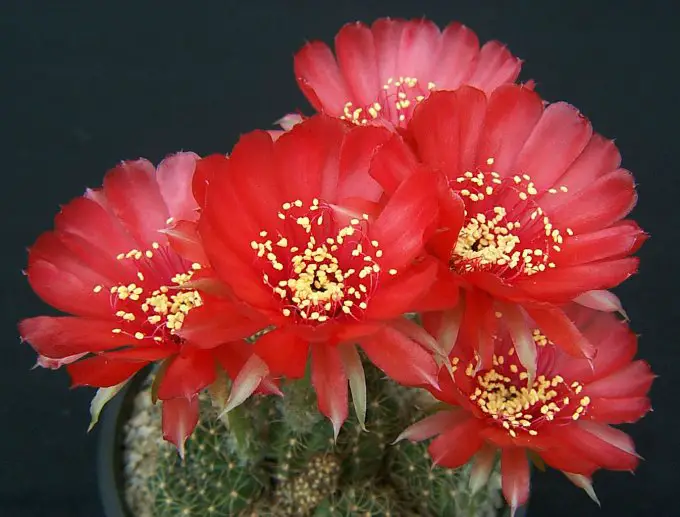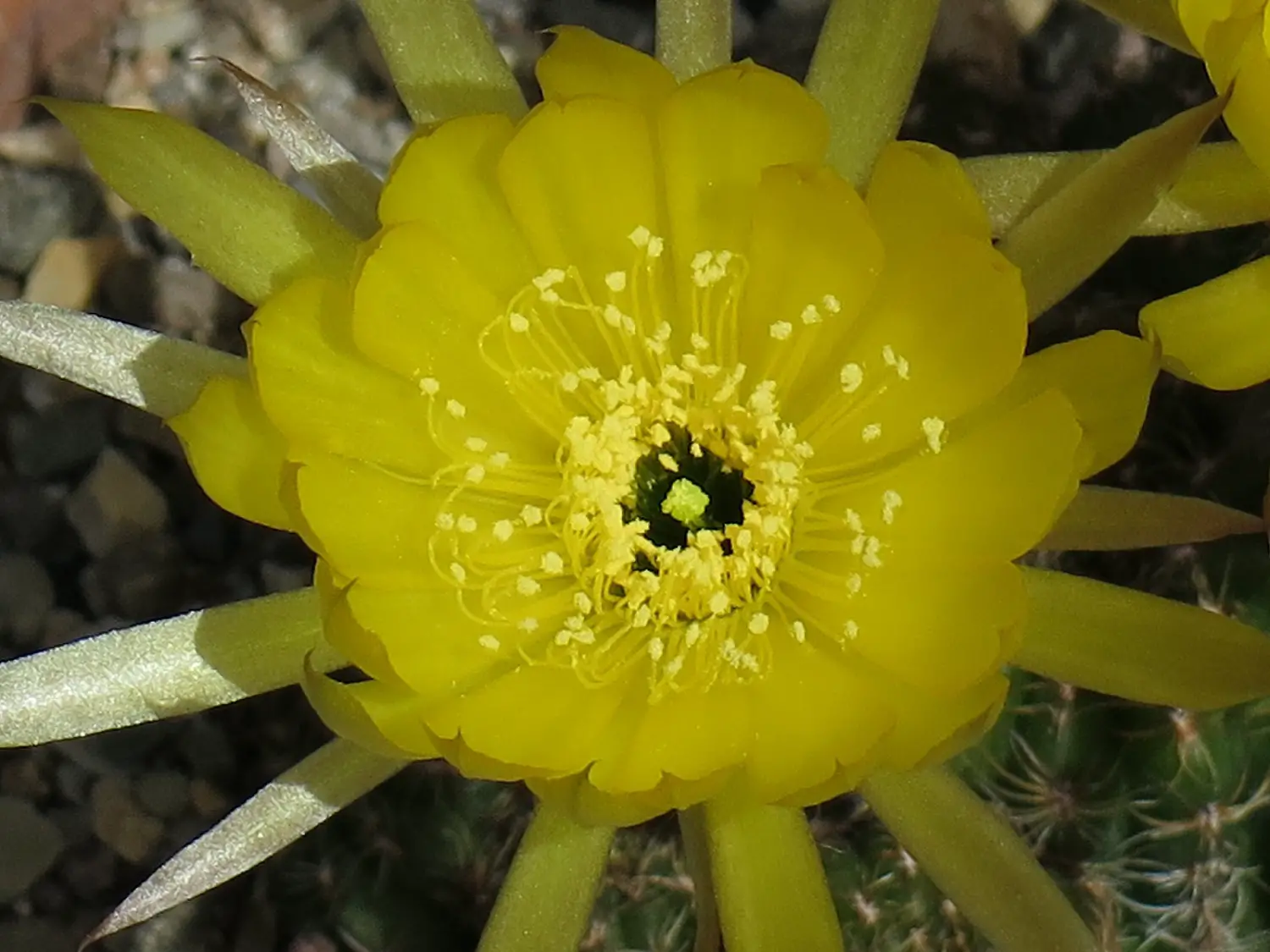There is something especially beautiful about coming across a black (or nearly black) flower. Dark-colored plants also contrast well with light-colored plants.
In nature, no plant can be truly black. When light hits a pigmented molecule, some light is absorbed and some light is reflected. Plants contain chlorophyll which reflects green light and absorbs red and blue light. It would not be possible for a plant to contain a pigment that absorbs all light.
However, some plants can be dark purple/almost black. This dark color can be attributed to a pigment called anthocyanin. This list describes some “black” succulents that might be worth adding to your plant collection.
Echeveria ‘Black Prince‘
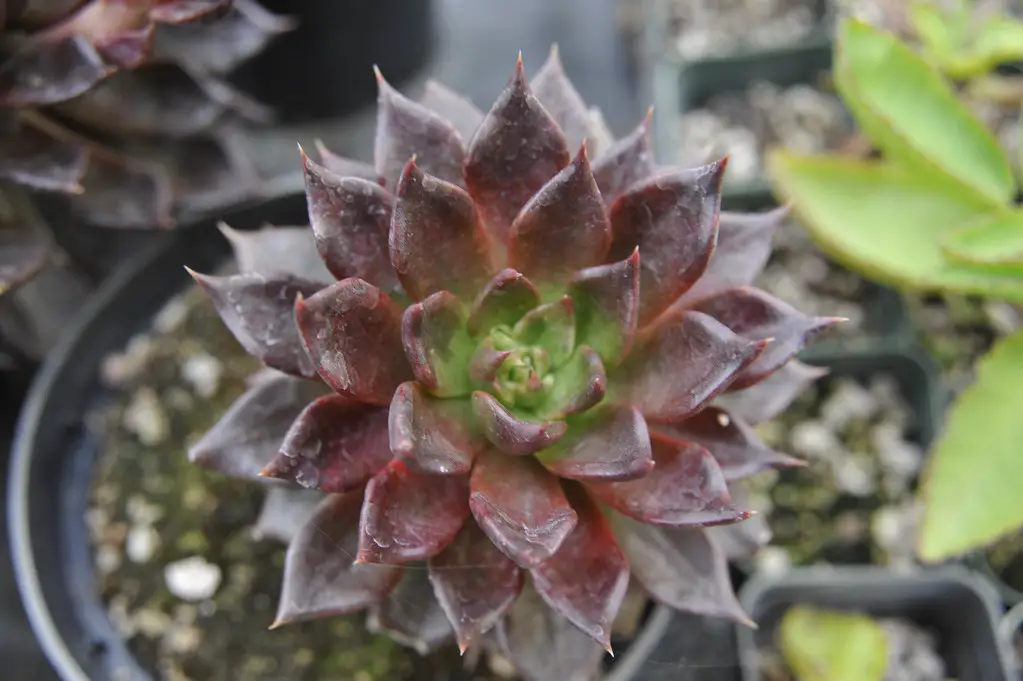
Echeveria ‘Black Prince” forms succulents that are deep green to black color. This is one of the most popular plants in the Echeveria genus. It is a cross between Echeveria affinis and Echeveria shaviana, which are succulents native to the deserts of Mexico.
The younger leaves, which are located in the center of the plant, tend to have a lighter green color, but they darken up as they grow. This type of succulent will grow well in gardens or outdoor containers in USDA Hardiness Zones 9-11.
Unfortunately, this plant will lose its beautiful dark color if it is not exposed to enough light. This means that it can be difficult to successfully grow Echeveria ‘Black Prince’ indoors. If you do attempt to grow Echeveria ‘Black Prince” indoors, I strongly recommend using grow lights to supplement natural sunlight.
Like other Echeverias, these plants will eventually produce beautiful blooms. These blooms typically show up during the late fall or early winter.

This plant has typical succulent watering needs. When you water this plant, soak the soil until you see water coming out of your container’s drainage holes. Then allow the soil to dry completely between watering sessions. Typically, these plants will require more water during the spring and summer. When watering this Echeverias, do not allow water to sit in the rosette. This can cause rot or fungal diseases.
Unfortunately, this plant seems to be particularly susceptible to mealybugs. If you start to see a white spiderweb-looking substance on your Echeveria, you probably have mealybugs. Ants are another sign of a mealybug infestation because ants like the sweet, honeydew substance that mealybugs produce. Personally, I have found horticultural sprays to be an effective way to get rid of mealybugs. However, some gardeners use soapy water sprays or alcohol sprays to get rid of mealybugs.
Aeonium Arboreum ‘Zwartkop‘
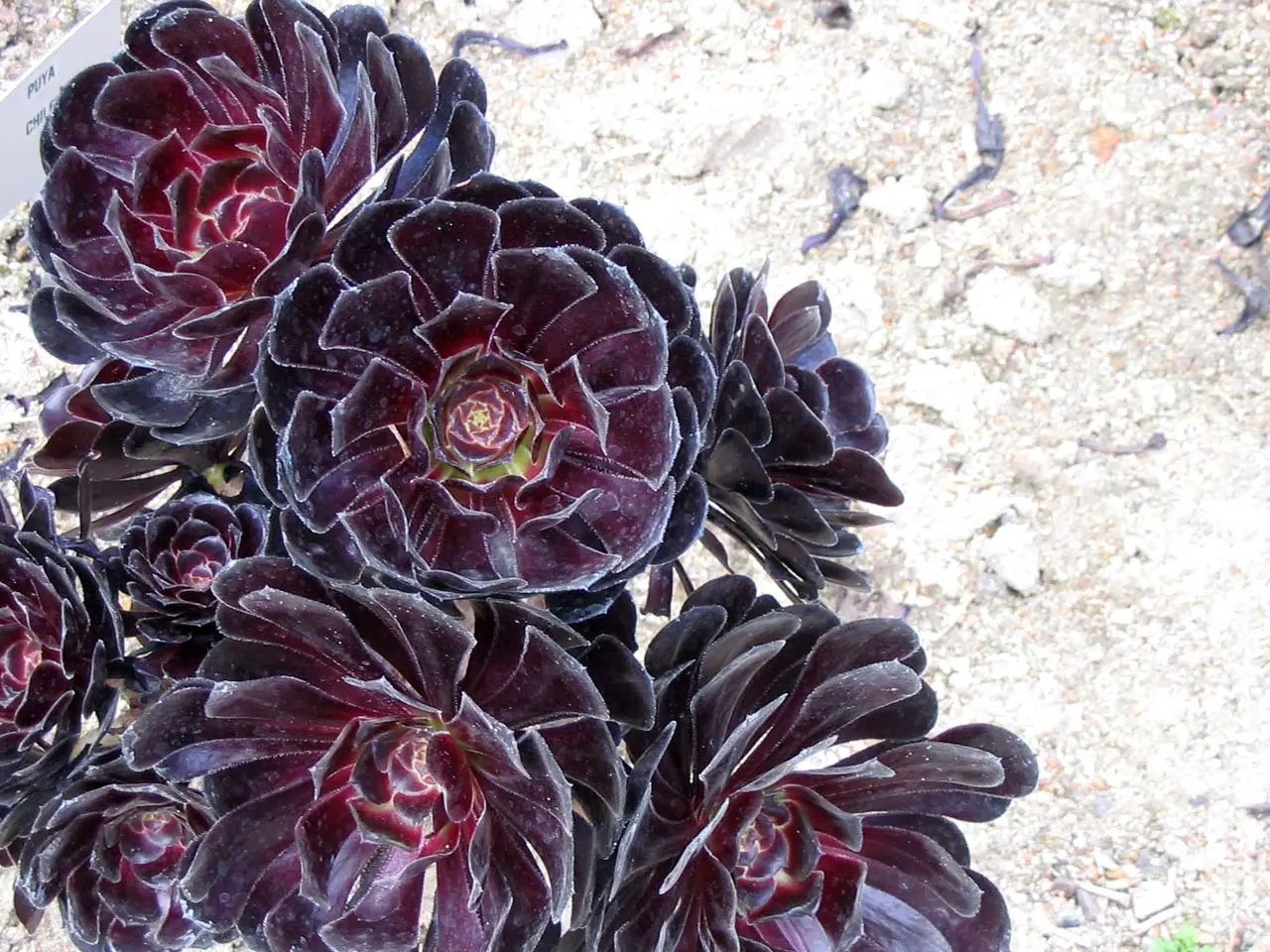
Aeonium Arboreum ‘Zwartkop’, which is commonly known as Black Rose or Large Purple Aeonium, is a tall dark red and green succulent. It is a hybrid of other species within the Aeonium genus. The parent plants are native to the Canary Islands in Africa.
These plants are probably the most popular succulent on this list. I see these succulents everywhere in Southern California. Not only do these succulents contrast nicely with light-colored succulents, but these plants also are not very difficult to care for and are not very fussy. If these plants are grown outdoors, they largely thrive on neglect.
Mature plants will produce yellow flowers during the springtime. These small clumps of flowers are rather striking.
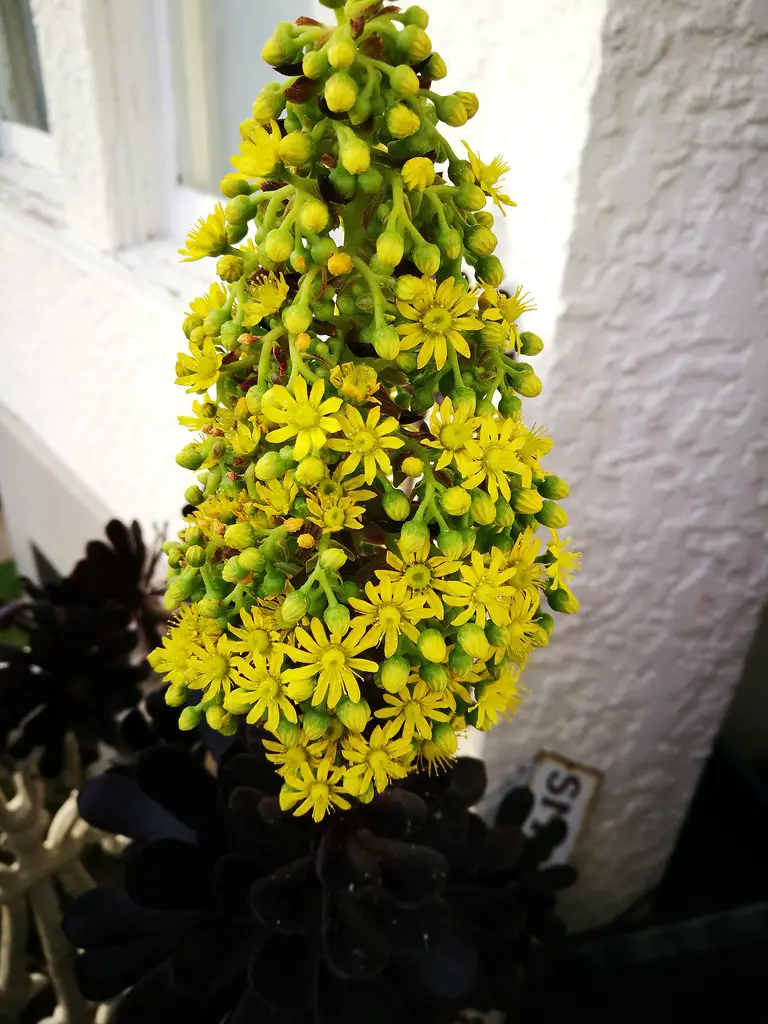
Like most Aeoniums, this plant will grow well in USDA Hardiness Zones 9 through 11. However, they can withstand mild frost. They do best in full sun to partial shade. If these plants do not receive enough sunlight, they will lose their dark coloring. They will also begin to stretch to seek out more light.
Water the plant thoroughly and allow the soil to dry completely between watering sessions. However, these succulents use more water than many other succulent species, so it is important to check the soil moisture regularly. I water my Large Purple Aeonium every week during the summer and every couple of weeks during the wintertime.
If you grow these plants in a container, it is best to re-pot every 2-3 years.
Sinocrassula Yunnanensis
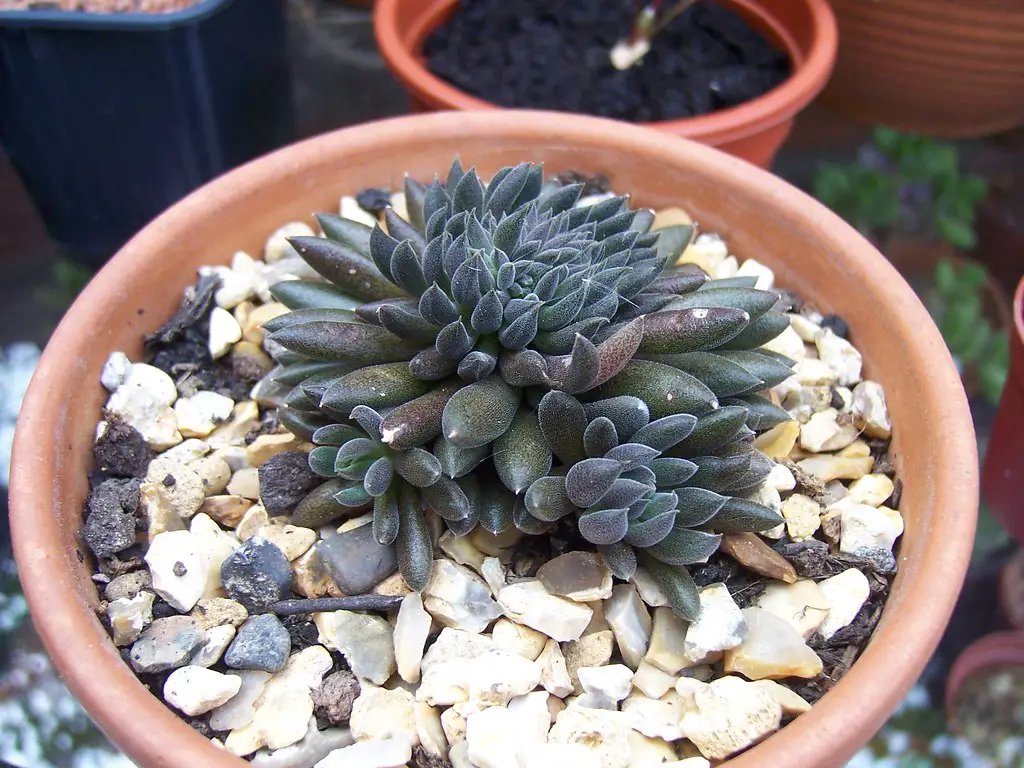
Sinocrassula yunnanensis, which is commonly referred to as the Chinese Jade, is a low-growing succulent that eventually grows into clumps that look like little hedgehogs. This species of succulent develops a dark color which gives it a striking appearance.
Sinocrassula yunnanensis is native to Yunnan Province in southwestern China. They grow at high elevations (2,500 to 2,800 meters). In the wild, these plants tend to grow in rock crevices.
Chinese Jade grows well in rock gardens as well as in containers with coarse, gravely soil. They like dry conditions and can survive off the water stored in their leaves for extended periods of time. Like other succulents, this plant is susceptible to root rot from overwatering.
Like many other types of succulents, Chinese Jade requires exposure to plenty of sunlight. These plants will do well in full sun to partial shade. During the hottest parts of the year, it needs some shade to avoid burning. However, if this type of succulent does not receive enough sunlight, it will lose its dark color.
Sinocrassula yunnanensis is a moncarpic plant that produces little white flowers. This means that it will flower once and die. Fortunately, this plant grows in clumps, so dead rosettes are quickly replaced with other rosettes.
This succulent can be difficult to find in the United States, but it is very popular in Japan and parts of Asia.
Echinopsis Ancistrophora ‘Arachnacantha’
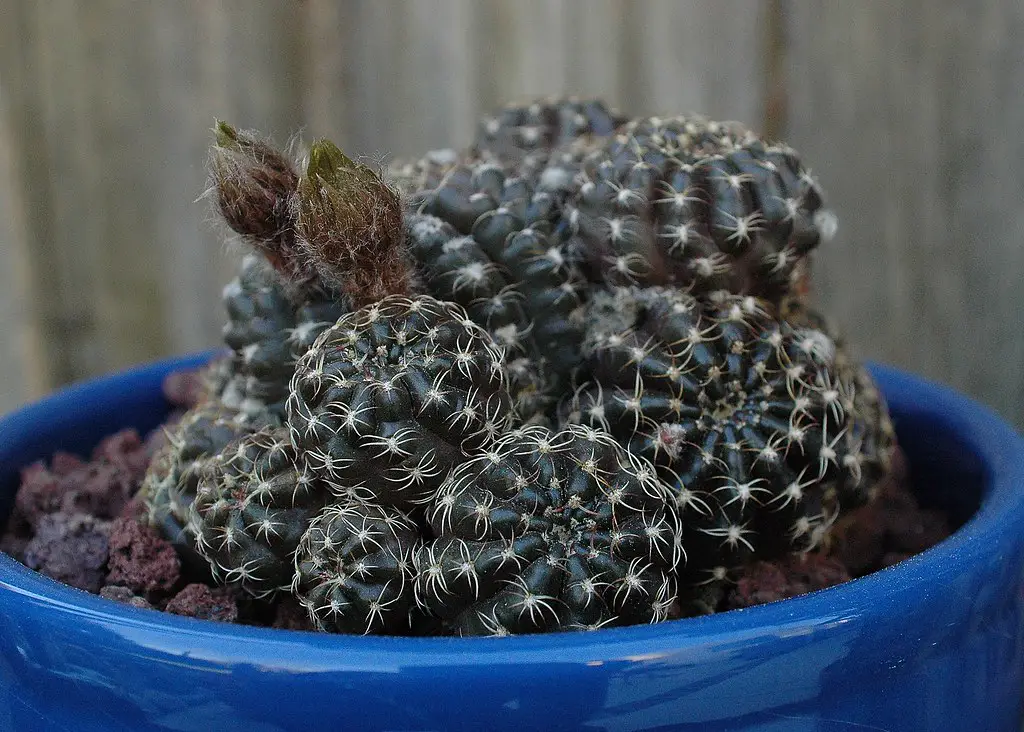
Echinopsis ancistrophora ‘Arachnacantha’ is a low-growing cactus that develops spidery spines and grows to a maximum height of 3 to 6 inches. Like many of the other plants on this list, this cactus is a hybrid. The parent plants are native to Bolivia and northern Argentina. They tend to grow on rocky surfaces with reliable summer rainfall.
In cultivation, they can be grown in USDA Hardiness Zones 9b to 12 as long as they are protected from frost. They can also be grown in a sunny windowsill. Eventually, this plant will produce colorful blooms. These cacti will grow well in full sun to partial shade. However, they should be slowly acclimated to hot, direct sunlight. Otherwise, they can be burned.
In general, these plants are easy to care for and thrive on neglect. However, it is important to ensure that this plant is grown in well-draining soil to minimize the chance of root rot. These cacti should be grown in gritty soil comprised of at least 80% coarse sand, perlite, gravel, and pumice. Echinopsis ancistroophora ‘Arachnacantha’ should also be grown in a container with drainage holes.
Although this plant is almost black during portions of its growing cycle, the color of this cactus will change significantly depending on maturity, light exposure, temperature, and many other factors.
This cactus should be watered regularly during the spring and summer months. Do not water this cactus during the winter months.
Sempervivum ‘Dark Beauty’
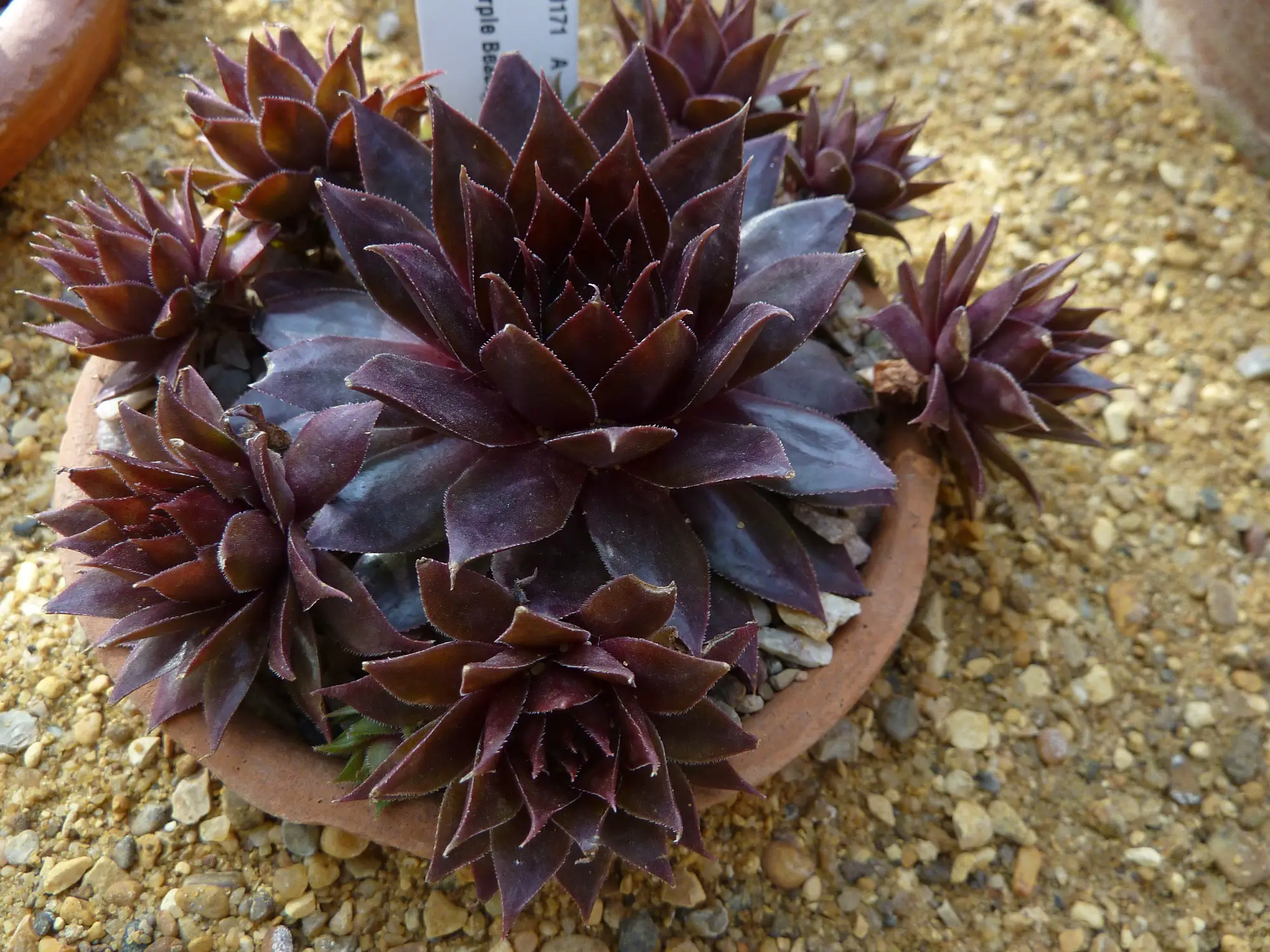
Sempervivum ‘Dark Beauty,’ which is commonly referred to as Hen and Chicks, is a low-growing succulent comprised of rosettes. These plants do not grow very tall. Rather, they spread laterally and grow as mats. This cultivar tends to have dark-colored foliage. Some plants will be green in the middle of each rosette. If they are not exposed to enough sunlight, these succulents will lose their dark color and become a plant green color.
Sempervivums are among the easiest succulents to grow. They are very versatile as they can be grown in outdoor gardens and containers within USDA Hardiness Zones 3 through 11. Sempervivums can also be grown indoors. While most types of succulents are native to tropical areas, Sempervivums are native to Europe. Traditionally, they were grown on rooftops in colder climates.
Like other Sempervivums, these plants are monocarpic. This means that the plant flowers once and then dies. However, the mother plant produces many pups before blooming.
It is best to water Sempervivum ‘Dark Beauty” thoroughly and allow the soil to dry completely. It is better to err on the side of under-watering these plants as they are susceptible to root rot. If you start to see crispy or wrinkly leaves, the plant probably needs more water. On the other hand, a spongy appearance may be an indication of overwatering.
To prevent overwatering your Sempervivum ‘Dark Beauty,’ make sure these plants are growing in gritty soil, sand, and gravel. Well-draining soil is arguably the most important part of properly caring for Sempervivums.
Haworthia Marxii
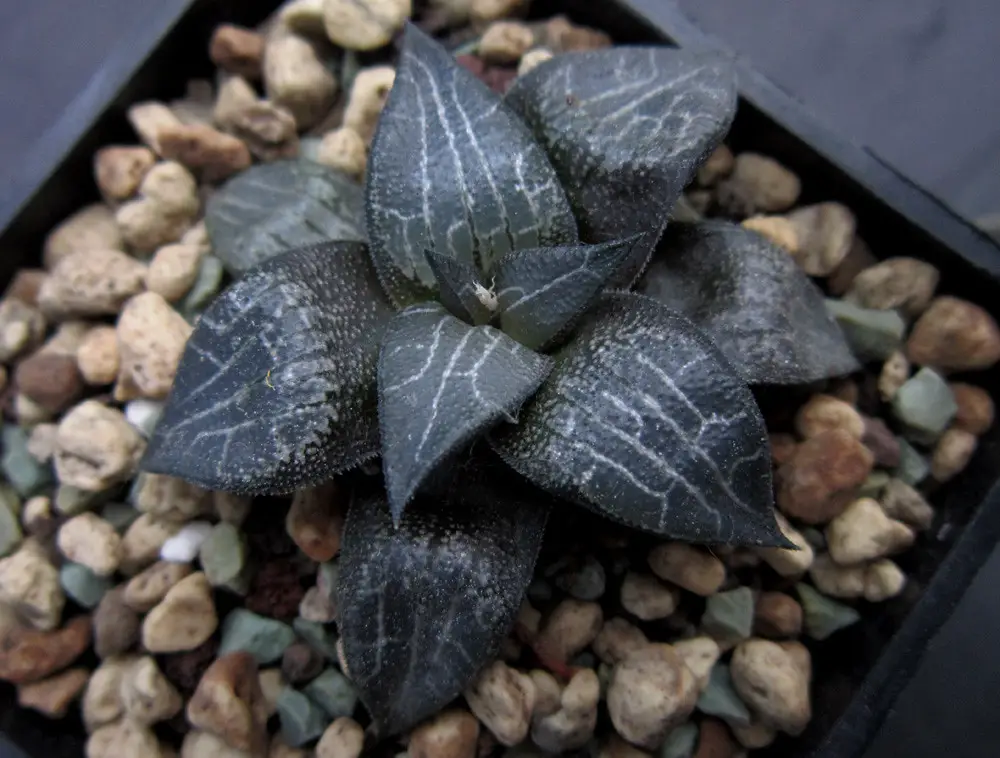
Unlike several other species on this list, Haworthia marxii is not a hybrid or cultivar. They are endemic to the Rooinek Pass within South Africa. In the wild, these plants grow in rock crevices or under shrubs. According to Gerhard Marx, over 80% of the plants belonging to this species never receive direct sunlight.
Haworthia marxii is one of the most challenging Haworthias to propagate. As a result, very little is known about these plants, and it is rare in cultivation.
In addition to being rare, this plant is notoriously difficult to grow. Unlike other species of Haworthia, this plant prefers to grow in shadier locations. This makes it a good plant for growers in the northern hemisphere with dark greenhouses. If Haworthia marxii is exposed to excessive light, it will lose roots and begin to wither (Marx, 2015).
Like other succulents, this plant should be grown in well-draining soil. Gerhard Marx, who is the South African botanist and artist this plant is named after, recommends growing this plant in a soil mix comprised of 80% perlite and 20% loam. This will most closely mimic the conditions in its native habitat.
In an effort to mimic its natural habitat, this plant should be watered sparingly throughout the year.
Echeveria affinis ‘Black Knight’
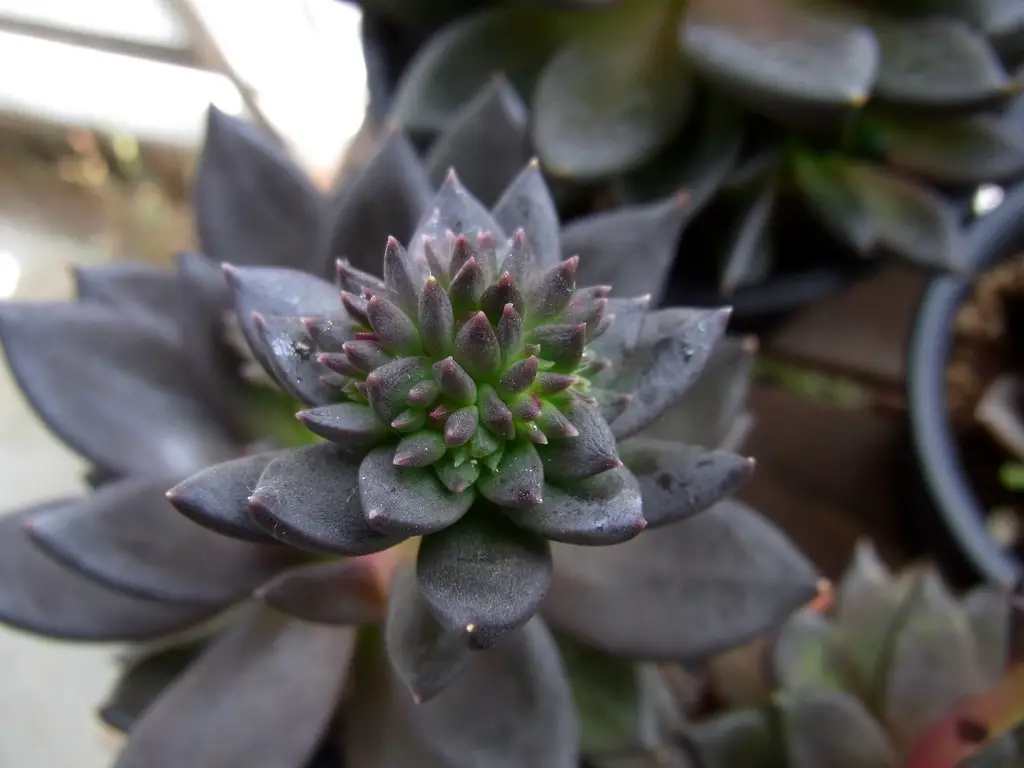
Echeveria affinis ‘Black Knight,’ which is commonly known as Mexican Hen and Chicks, is not a hybrid like some of the other succulents on this list. In fact, many professional consider Echeveria affinis ‘ Black Knight’ an obsolete name as the species is variable. This quote from the International Crassulaceae Network explains it best.
“This collection differs from that of the type (see the C&SJ., 30:195) in its blacker, slightly differently shaped leaves. Collected by R. J. Taylor under bushes and trees on the road between Mazatlan and Durango, Mexico. The surrounding country is mountainous, the altitude about 5000′ with rains even in summer.”
ISI 269 (1959)
However, many nurseries still sell this plant as Echeveria affinis ‘Black Knight,’ so I will continue to use it in this article.
This plant is native to Central and South America. Echeveria affinis ‘Black Knight’ can be grown outdoors in USDA Hardiness Zones 9 and above. It can also be grown successfully indoors as long as there is enough sun exposure.-
Like other Echeverias, this plant is not very difficult to grow. If it is properly cared for, it will produce red blooms during the fall or winter.
This plant has typical succulent watering needs. When you water this plant, soak the soil until you see water coming out of your container’s drainage holes. Then allow the soil to dry completely between watering sessions. Typically, these plants will require more water during the spring and summer. When watering this Echeverias, do not allow water to sit in the rosette. This can cause rot or fungal diseases.
As previously mentioned, Echeverias are susceptible to mealybugs. It can be difficult to spot these insects sometimes because they like to hide under leaves.
Haworthia Nigra
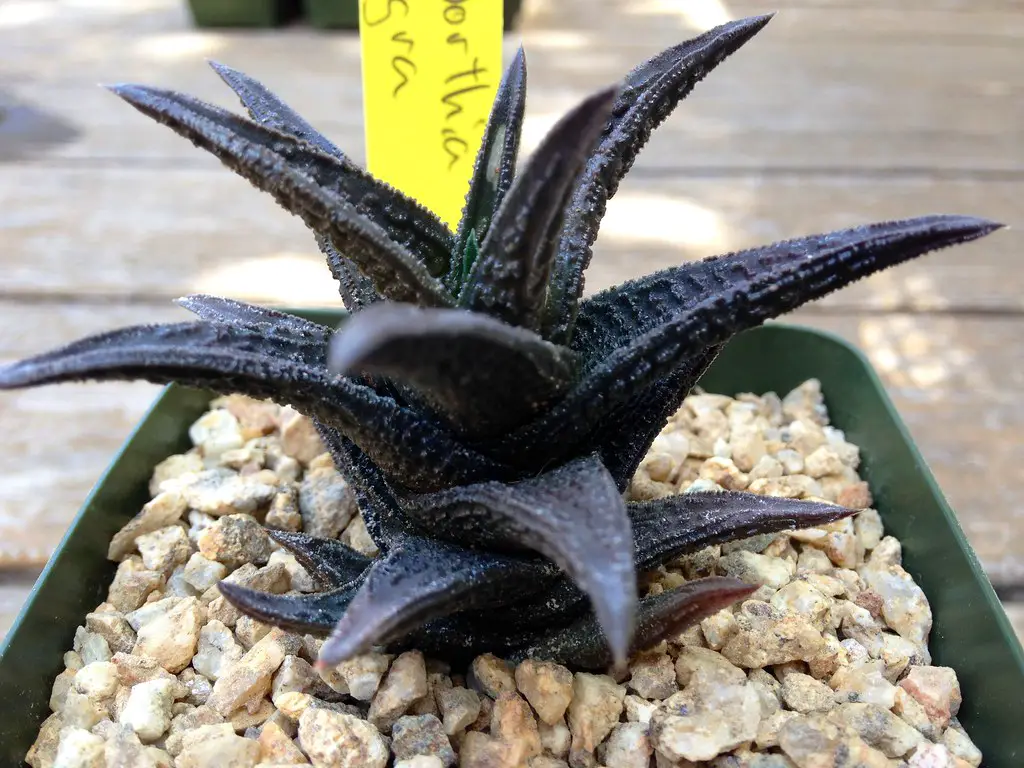
Haworthia nigra is a slow-growing succulent that is native to the Karoo desert in the Eastern Cape of South Africa. Like Haworthia marxii, this plant grows under bushes. However, they are sometimes found growing in full sun. They will have a darker color if exposed to high light.
These plants can be grown outdoors in USDA Hardiness Zones 10a to 11b. They can also make good houseplants. Like the other Haworthias on this list, overwatering is the biggest threat to Haworthia nigra. New leaves grow on top of older leaves which gives this plant a stacked or tiered appearance.
Although these plants generally stay black if they are exposed to enough light, they will “blush” if exposed to cold temperatures or drought. During the late spring or summer, these plants will produce pale white or lavender flowers. These blooms have an appearance that is typical of Haworthias.
Haworthia nigra has watering needs that are typical of succulents. They grow best when watered thoroughly and allowed to dry completely before the next watering session.

